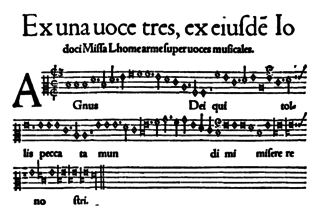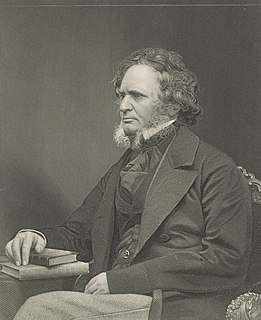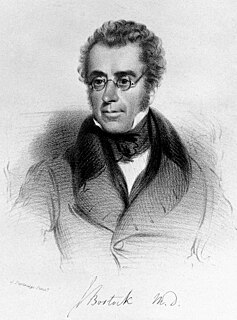
In music, a prolation canon is a type of canon, a musical composition wherein the main melody is accompanied by one or more imitations of that melody in other voices. Not only do the voices sing or play the same melody, they do so at different speeds. Accompanying voices may enter either simultaneously or successively. If voices extend the rhythmic values of the leader, a procedure known as augmentation, the resulting canon can be called an augmentation canon or canon by augmentation or sloth canon. Conversely, if they reduce the note values in diminution, it can be called a diminution canon or canon by diminution.
In Western music and music theory, augmentation is the lengthening of a note or interval.

The 1859 British general election in Ireland produced the last overall victory for the Conservatives in Ireland. They won a majority of seats on the island despite the Liberals receiving over 60% of the vote; this was partly due to a disproportionately large number of Conservative candidates standing unopposed. The franchise was restricted to the middle and upper classes.
In music, a transformation consists of any operation or process that may apply to a musical variable, or rhythm in composition, performance, or analysis. Transformations include multiplication, rotation, permutation, prolation and combinations thereof.

Ausmultiplikation is a German term used by the composer Karlheinz Stockhausen to describe a technique in which a long note is replaced by shorter "melodic configurations, internally animated around central tones", resembling the ornamental technique of divisions in Renaissance music. Stockhausen first described this technique in connection with his "opus 1", Kontra-Punkte, composed in 1952–53, but in his later formula composition there is a related method of substituting a complete or partial formula for a single very long tone in a much slower, "more background" projection of the formula. When this is done at more than one level, the result is reminiscent of a fractal.
Fioritura is the florid embellishment of melodic lines, either notated by a composer or improvised during a performance. It usually involves lengthy, complex embellishments, as opposed to standardized local ornamental figures such as trills, mordents, or appoggiaturas, and its use is documented as early as the thirteenth century. The alternative term "coloratura" is less accurate. It is closely related to the sixteenth-century practice of diminution or division.
Kimball Laundry Co. v. United States, 338 U.S. 1 (1949), affirmed the principle set forth in The West River Bridge Company v. Dix et al., 47 U.S. 507 (1848); that is, that intangible property rights are condemnable via the eminent domain power, and that just compensation must be given to the owners of such rights.
Samuel Barber's Symphony in One Movement, was completed 24 February 1936. It was premiered by Rome's Philharmonic Augusteo Orchestra under the baton of Bernardino Molinari 13 December 1936. It lasts around 21 minutes. The title given in the printed score of the work is First Symphony , and the uniform title is Symphonies, no. 1, op. 9.

John Bostock, Jr. MD FRS was an English physician, scientist and geologist from Liverpool.
Diminution in value is a legal term of art used when calculating damages in a legal dispute, and describes a measure of value lost due to a circumstance or set of circumstances that caused the loss. Specifically, it measures the value of something before and after the causative act or omission creating the lost value in order to calculate compensatory damages.

Branch retinal artery occlusion (BRAO) is a rare retinal vascular disorder in which one of the branches of the central retinal artery is obstructed.

Safeway Stores plc v Burrell [1997] ICR 523 is a UK labour law case, concerning redundancy.
The creaky-voiced glottal approximant is a consonant sound in some languages. In the IPA, it is transcribed as ⟨ʔ̞⟩ or ⟨ʔ̰⟩. It involves tension in the glottis and diminution of airflow, compared to surrounding vowels, but not full occlusion. It is an intervocalic allophone of a glottal stop in many languages. It is reported to be contrastive only in Gimi in which it is phonologically the voiced equivalent of the glottal stop.
Leaf size of plants can be described using the terms megaphyll, macrophyll, mesophyll, microphyll, nanophyll and leptophyll in a classification devised in 1934 by Christen C. Raunkiær and since modified by others. Definitions vary, some referring to length and others to area. Raunkiaer's original definitions were by leaf area, and differed by a factor of nine at each stage. Some authors simplified the system to make it specific to particular climates, and have introduced extra terms including notophyll, picophyll, platyphyll and subleptophyll.
Prelude and Fugue in C sharp Major, BWV 848, is a keyboard composition written by Johann Sebastian Bach. It is the third prelude and fugue in the first book of The Well-Tempered Clavier, a series of 48 preludes and fugues by the composer.

100 Leadenhall, nicknamed The Diamond, is a mixed-use development approved for the City of London. Designed by Skidmore, Owings & Merrill, the tower will be the financial district's third-tallest building upon completion. The wedge-shaped building will have a facade of elongated diamond shapes.







